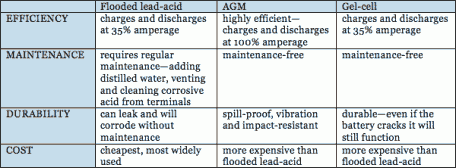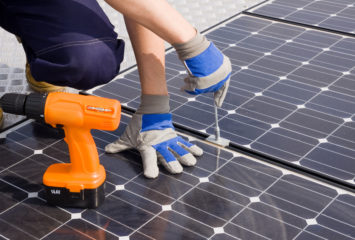How to Choose a Battery Bank for Your Solar PV System
If you’re going off-grid with your solar PV system you’ll need a battery bank to store your energy for nighttime and cloudy days. Lead-acid batteries, the dominant battery type for solar PV systems, have been around for years. Though they look similar to car batteries, solar PV batteries operate on a deep-cycle principle—they are intended to deliver small charges for a long time rather than short bursts of intense energy as with car batteries.
Aside from the most common flooded lead-acid type of battery, a couple of other options exist: gel-cell and sealed absorbent glass mat (AGM). Batteries are often considered the weakest link in a solar PV system since they will wear out quicker than the other parts, reducing the system’s performance. Keep the chain as strong as possible by purchasing the right product and purchasing high quality.
Deciding on a Battery Bank
- Determine how many watt-hours your system will consume by following “How to Properly Size your Solar PV System.”
- Decide how many days of stored energy you would like for your system. Ask yourself how important autonomy is to you. Are you fine with being grid-tied? If so, you don’t even need batteries. Are you OK with using a backup fossil fuel energy source or do you want your system to be powered by renewable energy at all times? Are you going off the grid completely or not? Do you want to be prepared for long blackouts? Once finding the answers to those questions decide how many days of storage you need. Most systems are sized for 1 to 5 days of storage capacity.
- Determine what type of battery is best for your application (see chart below)
- Since lead-acid batteries typically drop 20 to 25% of their capacity while operating in 30ºF temperatures, plan to house them somewhere warm (ideally between 50 and 85ºF, with 77ºF as the optimal temperature). If you cannot keep them somewhere warm, purchase additional batteries to compensate.
- Simple is best when deciding on a battery bank. Choose a single series string of cells because there is less that can go wrong than with multiple strings and they are easier to replace when broken.
- If you foresee yourself expanding your system, buy a larger battery bank than you think you will need since battery banks cannot be easily expanded. Overtaxing your battery bank also leads to a chronic undercharged condition that can cause the batteries to fail prematurely. As a general rule of thumb, aim for 30 to 40% more energy than the load demands.
Additional Components
- Buy a battery monitor system (BMS) and install it where it’s easily visible. Using these devices to manage your batteries can increase their lifespan and make maintenance easier.
- Purchase a charge controller that includes temperature compensation as one of its features. This is important since it can prevent warm batteries from overcharging and assist cold batteries in getting the extra charge they need. In order for temperature compensation to work, you have to purchase a temperature sensor and place it next to the batteries.
- Assess how likely you are to regularly water your batteries. Just like your plants, if you neglect your batteries, they will die. In that case, buy a battery watering system.



Comments are closed here.